Introduction
Common ragweed (Ambrosia artemisiifolia) is an herbaceous plant in the Asteraceae family native to North America. It is a successful pioneer species widely distributed throughout the continental United States. Common ragweed is most often found in frequently disturbed habitats such as cultivated fields, orchards, landscapes, nurseries, roadsides, and waste places. In Florida, it is especially abundant along ditch and canal banks, places where its seeds are easily disseminated into cultivated fields. Common ragweed growing in cultivated fields will compete with crops for light, moisture, nutrients, and space and will result in significant yield losses. Additionally, allergenic airborne pollen from common ragweed is a primary cause of hay fever and thus a public health concern.
Biology and Life Cycle
Common ragweed is an erect, branching summer annual that can rapidly grow to more than 7 feet tall (Figure 1). As a prolific seed producer, it is capable of producing 32,000 to 62,000 seeds per plant when growing without any competition. These seeds can survive and remain viable for many years in undisturbed soil. Dormant common ragweed seeds require a period of exposure to cold temperatures to germinate. Germination is optimal in the spring at soil temperatures of 50°F to 80°F. However, temperatures above 86°F will halt germination and send the seeds back to dormancy until a repeat of the cold requirement the following winter.
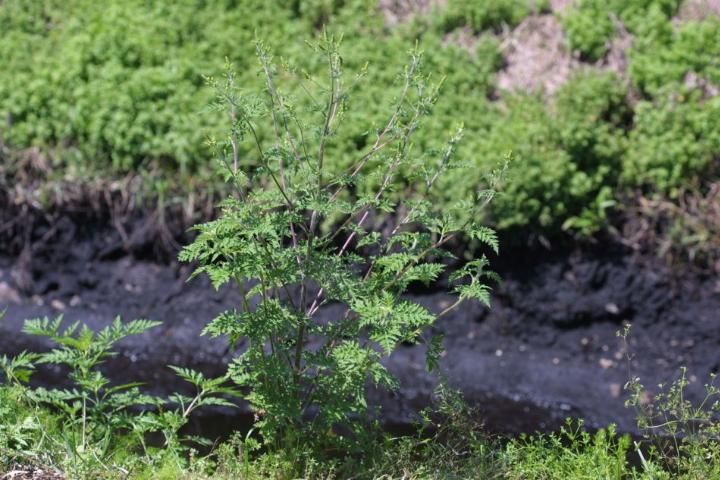
Credit: Calvin Odero, UF/IFAS
Seedling
Measuring 0.2–0.4 inches long, the cotyledons are thick, dark green, spatulate, and often deep purple underneath. The first true leaves are lobed and hairy (Figure 2). Subsequent leaves are deeply cleft on the margins, forming rounded or slightly pointed lobes (Figure 3). The youngest leaves are initially opposite but later become alternate at the forth node. The blades are hairy, but the underside is densely hairy compared to the upper surface and margins.
Mature Plant
Stems are green to purple, erect, and branching above; also, they have long rough hairs (Figure 4) with a shallow taproot that produces a fibrous root system. The leaves are compound, deeply lobed, and usually much wider at the base than the tip. Mature leaves are relatively hairless, but small leaves often have hairs on the underside. In some biotypes, leaves will remain hairy throughout their entire growth cycle. Petioles are present on lower leaves and absent in upper leaves. Lower leaves are arranged oppositely while upper leaves are often arranged alternately on the stem of older plants. Inconspicuous small (1/8 inch long), green male and female flowers are present on separate heads on the same plant. Male flowers, usually drooping, are at the top of the plant, and female flowers are in the axils of the upper leaves and branches (Figure 5). Individual plants produce in excess of 1 billion wind-dispersed pollen grains. A single small seed is enclosed within each fruit, which has several longitudinal ridges ending in short spines resembling a crown.
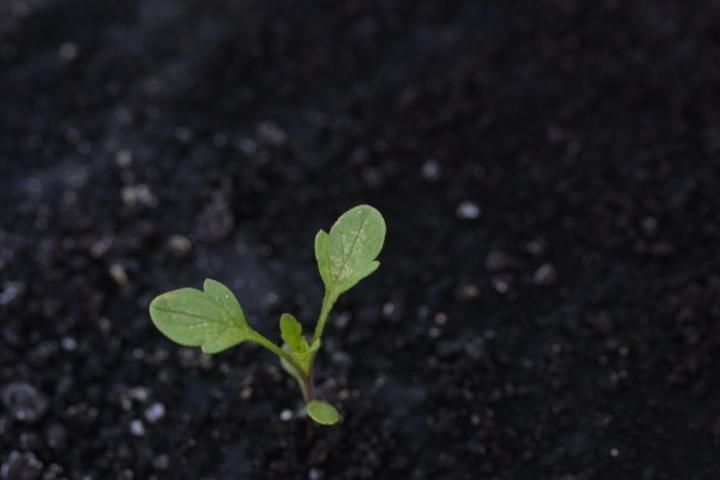
Credit: Calvin Odero, UF/IFAS
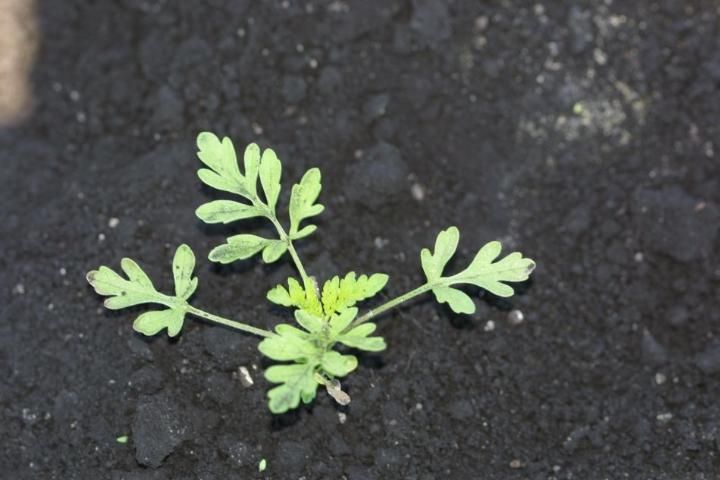
Credit: Calvin Odero, UF/IFAS
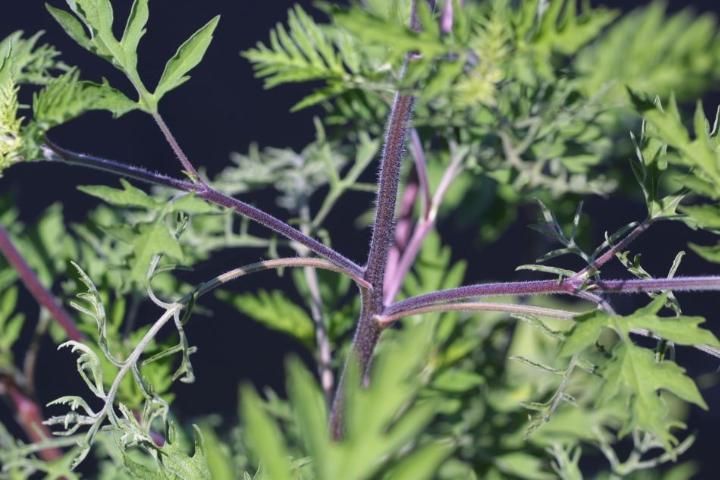
Credit: Calvin Odero, UF/IFAS
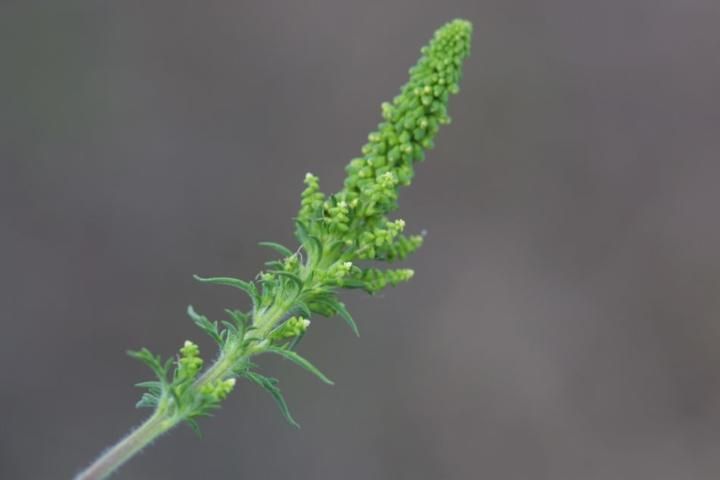
Credit: Calvin Odero, UF/IFAS
Management
Controlling common ragweed along ditch and canal banks using a combination of mechanical and chemical options is an inexpensive way of reducing new seed introduction into cultivated fields. Mowing can be used to control common ragweed by exhausting and depleting its reserves and thus prevent it from seed production. This should be done as close as possible to the ground to minimize regrowth. However, mowing plants with mature seeds will likely increase seed dispersal. Mowing before flowering in combination with an herbicide treatment on re-sprouted plants will result in effective control. Common ragweed can be controlled successfully using herbicides. Good control of common ragweed can be achieved with applications of glyphosate (several trade names) at 1 pint per acre (equivalent to 0.25% v/v) when weeds are less than 6 inches tall, 2 pints per acre (equivalent to 0.5% v/v) when weeds are 6 to 12 inches tall, and 2.75 pints per acre (equivalent to 1% v/v) when weeds are greater than 12 inches tall. If an additional flush occurs, repeat applications of glyphosate can be made, but the maximum annual application rate (14 pints per acre per year) must be followed. Addition of dry ammonium sulfate at 1%–2% w/v (8.5–17 pounds per 100 gallons) may increase the performance of glyphosate, particularly under hard water and drought conditions. The equivalent of liquid formulation of ammonium sulfate may also be used. Overreliance and repeated use of glyphosate for common ragweed control can greatly increase selection pressure for traits that allow it to be glyphosate-resistant.
Glyphosate-resistant common ragweed was first reported in Missouri in 2004 and has since been reported in Arkansas, Ohio, Indiana, Kansas, North Dakota, and Minnesota. Presently, no glyphosate-resistant common ragweed biotypes have been reported in Florida. To prevent development of glyphosate-resistant common ragweed, overreliance and repeated use of glyphosate should be minimized; also, tank mixes or sequential treatments of herbicides with different modes of action (for example, 2,4-D and saflufenacil), but which are active on common ragweed, should be used along with glyphosate. Consequently, prevention of resistance occurrence in Florida becomes an easier and cheaper option than management of confirmed resistance.
Application of 2,4-D at 2 to 4.2 pints per acre (equivalent to 0.08%–0.16% v/v) when common ragweed is young and actively growing will provide good control. Tank mixing 2,4-D at 1 pint per acre with glyphosate at 2 pints per acre will provide better common ragweed control. If 2,4-D is used, the Florida Organo-Auxin Herbicide Rule (see https://edis.ifas.ufl.edu/publication/wg051) must be consulted prior to application in order to prevent spray drift to sensitive crops. Saflufenacil (Sharpen) applied as a burndown can effectively control common ragweed at 1 to 2 fluid ounces per acre (equivalent to 0.02%–0.08% v/v). For optimum burndown, methylated seed oil (1% v/v) plus either ammonium sulfate (1-2% w/v) or urea ammonium nitrate (1.25%–2.5% w/v) must be used. When using these herbicides, water levels in canals or ditches should be dropped to remove standing water prior to application especially if the water is to be used for irrigation.
References
Buttenschon, R. M., S. Waldispühl, and C. Bohren. "Guidelines for Management of Common Ragweed, Ambrosia artemisiifolia." Accessed September 14, 2018. http://internationalragweedsociety.org/smarter/wp-content/uploads/Ambrosia-management-guidelines-2009_AMBROSIA-EUPHRESCO_eng.pdf
DiTommaso, A. 2004. "Germination behavior of common ragweed (Ambrosia artemisiifolia) populations across a range of salinities." Weed Science 52:1002-9.
Heap, I. "International Survey of Herbicide Resistant Weeds." Accessed February 1, 2023. http://www.weedscience.com
Jordan, T., G. Nice, R. Smeda, C. Sprague, M. Loux, and B. Johnson. "The Glyphosate, Weeds, and Crop Series - Biology and Management of Common Ragweed." Purdue Extension, GWC-14. Accessed February 1, 2023. https://ag.purdue.edu/btny/purdueweedscience/wp-content/uploads/2021/01/gwc-14.pdf
Uva, R. H., J. C. Neil, and J. M. DiTomaso. 1997. Weeds of the Northeast. Ithaca: Cornell University Press.
Wilson, R. G. and J. Furrer. 1996. "Where do weeds come from?" University of Nebraska-Lincoln Cooperative Extension, G86-807-A.